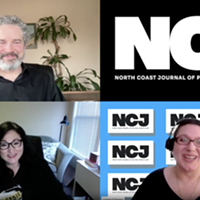[
{
"name": "Top Stories Video Pair",
"insertPoint": "7",
"component": "17087298",
"parentWrapperClass": "fdn-ads-inline-content-block",
"requiredCountToDisplay": "1"
}
]
The Humboldt marten is about the size of a 4-month-old human baby and adorable, with small, round ears, a fluffy tail and a button nose. Don't let these looks fool you. This member of the weasel family is a voracious predator that fights hard for a spot in the animal kingdom, taking down large rodents such as squirrels and woodrats. The elusive, nocturnal critters are hard to spot, even for those researching them. "Don't expect to see one," warns Micaela Gunther, a behavioral ecologist researching martens at Cal Poly Humboldt, to her master's students. Its dwindling population — it's listed as threatened under the U.S. Endangered Species Act — doesn't help, as it has been extirpated from 95 percent of its historic range.
Unfortunately, we're not just at risk of losing the Humboldt marten but also the very thing that could save them: traditional ecological knowledge or TEK. TEK is the body of expertise accumulated by Indigenous people concerning their environment and relates to both a spiritual and ecological understanding of nature. According to Tiana Clausen-Williams, a Yurok tribal member and director of the Yurok Tribe Wildlife Department, the loss of ancient knowledge is the reality for many Indigenous tribes in the U.S. With colonization came relocation, and the Yurok were removed from their homes, no longer allowed to speak their language, wear traditional clothes or sing traditional songs. "My own uncle was sent to Riverside. ... The graveyards full of children are astounding," remarks Clausen-Williams. "Many folks didn't pass down traditional knowledge because they were so scarred by these experiences. They didn't want their children to have to go through that. Sometimes I feel like I'm missing parts of who I am as a Yurok person because the knowledge wasn't passed on to me... Humboldt marten are used in our ceremonies and regalia, and it's impactful when a major contributing spirit is no longer there," she says. "I personally don't know the story of the marten to Yurok ... I wish I did, and I know there has got to be a reason."
Efforts to restore TEK are ongoing for the Yurok Tribe in the form of language revitalization, ceremonial dances and consultation with tribal elders. According to Clausen-Williams, how to live in relationship with the world around you is central to the Yurok tradition. Unlike settler ideals of independence and self-sufficiency, "We believe you can't exist in isolation. It's impossible to be independent. You exist in reciprocity."
TEK demonstrates the impossibility of saving the Humboldt marten without first saving its environment. The marten relies on old growth forests that house a variety of habitat features benefiting all sorts of species. In particular, increasing woody debris from the trees contributes to sustaining Humboldt marten prey and the marten's denning sites. "Rather than seeing the forest solely as an economic opportunity, we consider it our responsibility to restore the forest for the health of the community," says Clausen-Williams. "We are here for the long haul. We want a forest that we can engage in relationship with, both for our and the forest's benefit."
The tribe's wildfire management practices are another crucial example of TEK and conservation. "The fact that tribes can't manage the land the way they once did is a major contributing factor to the disastrous wildfire season we have right now," remarks Clausen-Williams.
According to Kent Barnes, a wildlife biologist for the Yurok Tribe who helped to establish the tribe's threatened and endangered species program, our forests are very dense. "The forest has ladder fuels," he says, "which happens when very dry lower branches enable a forest fire on the ground to climb right up into the canopy. We're performing variable density thinning to allow trees to reach old-growth potential at a much quicker rate. This will reduce fuel loading so that catastrophic wildfires are less likely to occur and a major threat to the Humboldt marten can be reduced."
Ultimately, improved collaborations between western scientists and Indigenous tribes is critical for wildlife conservation in general and protecting the Humboldt marten specifically. "If you have a conservation objective, it's essential to get out on the ground. A strong relationship with the tribe can be a good surrogate for this because we are an integrated part of the system," remarks Clausen-Williams. "One of the keys is being able to practice really listening ... as you continue to have conversations, it's clear that TEK is the answer. But you have to invest the time into it." Even if you never see the fierce little critter hiding in the forest.
Katherine Larson (she/her) is an undergraduate student studying wildlife conservation and management at Cal Poly Humboldt.
Speaking of...
-

'Our Food is Our Medicine'
Mar 28, 2024 -

The Reluctantly Famous Shoshoni Hostler
Feb 15, 2024 -

Butterflies, Real Estate Mysteries and Pop-up Dining
Jan 26, 2024 - More »

































